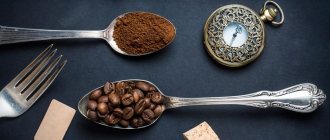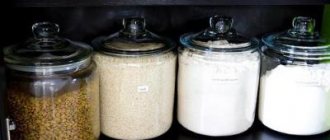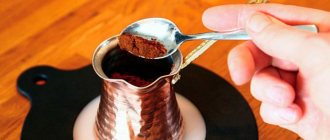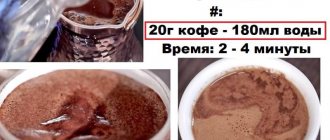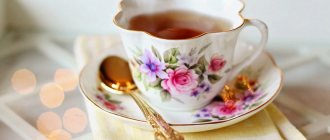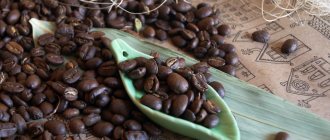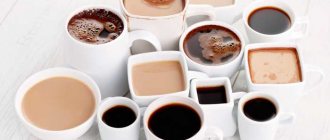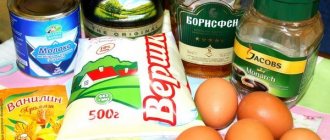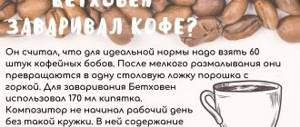About a teaspoon
It is worth saying that spoons have always been an integral attribute in human life. Their story began even before the discovery of iron. Previously, people used their wooden counterparts or used pieces of nut shells and similar shaped stones as table devices. As for Rus', even during the reign of Peter I, the boyars actually did not have their own dishes, including cutlery. At this time, spoons were a sign of luxury and the highest culture. It was only around 1760 that spoons acquired their usual form, which was very comfortable to use. From that same time on, spoons began to be divided according to size and purpose, becoming an integral part of people’s lives. As for the teaspoon, now it can be made from a variety of materials: wood, aluminum, plastic, precious metals such as silver or even gold. Very often, modern manufacturers produce teaspoons with different combinations of metals: a stainless steel handle can be decorated with ivory, and a silver spoon can be plated with gold.
How to choose a dessert spoon
Basically, the table is served with dessert spoons for special occasions, usually on holidays and memorable dates. Therefore, ideally you should acquire a special one. Spoons from holiday sets differ from ordinary cutlery:
- more expensive and beautiful materials;
- exquisite ornaments, patterns and monograms;
- at a price.
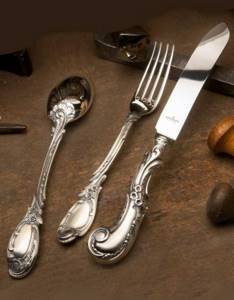
Advice!
If your everyday cutlery set does not contain dessert spoons because they are unnecessary, then your holiday set must have them.
Classic holiday cutlery set
Often, holiday dessert spoons are made of silver. This tradition came to us from our ancestors. Even in ancient novels you can find the phrase “family silver.” It is passed down from generation to generation and is rightfully a source of pride for all family members.
Advice!
Silver spoons will be an excellent gift for an anniversary or a wedding, as they will be useful in any family that receives guests.
Collection set of dessert spoons “Views of Moscow”
If you did not inherit family silver, then who is stopping you from starting this wonderful tradition yourself and becoming its founder? Of course, this is an expensive pleasure. Therefore, it is recommended to start small. Don't buy the whole set. Focus on purchasing dessert spoons first and then add to your collection as you can. This can turn into a real hobby! And such a collection can be born with the purchase of one silver dessert spoon. In addition, the latter has always been considered a wonderful gift for a newborn.
An unusual surprise for guests - chocolate dessert in a spoon. New Year's table setting with dessert cutlery.
However, despite the simplicity of the rules, many do not take them seriously or simply forget about them. In order to feel like a real esthete and gourmet during every meal, let’s remember the basic rules for setting the table using dessert spoons.
So, a dessert spoon is used for serving sweet dishes. Therefore, it is smaller in size than a tablespoon. However, not everyone knows that a dessert spoon can also be served when setting the table with a tureen of broth. In this case, a saucer with such a spoon is placed next to it.
The most pressing question is regarding the place allocated to the dessert spoon on the table. It is placed above the plate so that the scoop lies sloping to the left. This rule applies when serving desserts that do not require cutting, such as mousse, pudding, fruit in syrup.
In everyday life, we make do with a couple of spoons - for soup and tea, one fork for everything and sometimes a knife. However, when we go on a visit, or receive guests at home, or go to a restaurant, we have to use cutlery, which sometimes confuses us.
Of course, it is very difficult to teach how to use cutlery via the Internet, but to give an idea of what knives, forks, or spoons are and what they are for
we can. First, we will get acquainted with the cutlery that is most often found. Let's look at them, in the photo of course.
Now let's get to know them better. Meat knife, large knife
The knife measures 20-24 cm. Served with meat or main dishes along with a meat fork. Served with large plates. Meat fork, large fork
The fork has a size of 19-21 cm. Served for hot appetizers, spaghetti served in a soup bowl. Serves as an addition to a soup spoon for dishes served in soup pots. Steak knife
It differs from a regular meat knife in its sharp, sharpened edge. Large soup spoon
It has a size of 19-21 cm. Served complete with a meat fork. Used for first courses or as a spoon for sauce. Broth spoon
It has a size of 16-17 cm. Served for soup in special broth cups. Spoon for pouring sauces, 18-19 cm
Typically for fish dishes with sauce Consommé spoon, size 14-15 cm
For soup served in consommé cups. Fish fork
It measures approximately 18 cm, with three cloves.
Served with a fish knife. Used for easily cut fish dishes, fish with scales and shelled seafood. Fish knife, size 19-21 cm
Served in pairs with a fish fork for the same dishes listed above. Not used for salmon, herring, and eel dishes. Oyster knife
Used to open oyster shells. As you know, oysters have valves, and they can only be opened with a knife that has a short blade and a pointed end.
The guard on the knife protects your hands from damage from the edges of the shell. Opening the oysters is done with or without gloves. The knife can be used to open shellfish. The knife comes with an oyster fork.
.
It has three short cloves, a wide base and is about 15 cm in size. Served with a coffee spoon. The spoon is used for seafood cocktails, which are served in cups. Lobster fork or spatula
, has a size of about 23 cm.
Used for cutting and eating lobsters, crabs, lobsters. The two sides of the fork have different purposes. With a sharp end, for extracting meat from claws, and with a deep, spoon-shaped end, for scooping out juice. Lobster tongs, size about 20 cm.
They are used for removing and splitting shells and cutting limbs. For cracking shells and cutting limbs of lobsters, lobsters, crayfish and crabs; size about 20 cm. In general, there are several types of knives. There are more complicated ones, forceps + scissors, they are used to cut lengthwise and unfold the edges. Simpler, they just break it. In any case, a lobster fork is used for eating. Crab fork, approximately 18 cm
Complete with a crab knife, used for cutting and eating crabs Crab knife, approximately 18 cm
Complete with a crab fork, used for cutting and eating crabs Snail tongs
When the snails are served without the shell, in a special container called a “Snail Bowl,” no tongs are required. If you brought hot snails in the wings, you need to eat them using tongs, which you need to hold in your left hand and a snail fork (photo below). With our right hand, in which we have a fork, we pick up the snail and put it whole into our mouth. Do it carefully! There is a risk of splashing! Snail fork
Mussels are eaten in the same way. caviar spoon,
size approx. 20 cm, made of mother-of-pearl or horn, approx. 20 cm
For caviar, placed in small vases Caviar knife
, just like the spoon, is made of horn or mother-of-pearl so as not to change the taste of the caviar.
Served to spread caviar on a sandwich or pancakes. Long fork or fondue fork
Serves for all types of fondue, meat, cheese, chocolate and fondue bowl or small or dessert knife, sizes 19-21 cm.
Used for butter and most cold appetizers along with a dessert fork, as well as for cheese and fruit. Can be used for caviar if there is no special knife for it. Dessert or small fork, size 18-19 cm.
Used for all of the above, as well as for baking and sweets along with a dessert spoon. Dessert or small spoon, size 18-19 cm
For desserts, sweets, pastries and first courses served in special broth plates. Butter knife, size 17 cm
We already talked about using a dessert knife for butter, but there is also a special butter knife. It's a little smaller. It can also be used for caviar. Cake fork, 15-16 cm
Place when serving baked goods, cakes, pastries. Coffee spoon, size 13-15 cm
The spoon is used for serving breakfast, tea, coffee, chocolate. Can be used when serving marmalade, honey, consommé, soft-boiled eggs, seasonings and side dishes, cream dessert, egg dessert, cocktails together with a dessert fork, for oysters and seafood cocktails in combination with an oyster fork. Mocha coffee spoon, size 10-11 cm
Serve for mocha coffee. Can be used for soup and spices served in special cups, as well as for small shells. egg spoon,
size 11 cm, mother-of-pearl, horn or plastic.
For soft-boiled eggs. Ice cream spoon, size 18 cm
The name speaks for itself, that is, for ice cream and dishes made from it. Lemonade spoon
Served with narrow glasses or tulip-shaped glasses into which soft drinks are poured - lemonade, juice or fruit drink, chilled tea. Citrus knife
For citrus pulp Citrus spoon
Served with a citrus knife Asparagus tongs
Using tongs, lift the asparagus from the grill to a plate. You need to eat asparagus with your hands. Corn cob knife
The corn cob is eaten by holding it with both hands. Here's another photo that shows some cutlery that isn't listed above or has a slightly different shape.
1 coffee spoon 2 tea spoon 3 dessert spoon 4 tablespoon 5 large pastry tongs 6 mixed drinks spoon 7 asparagus tongs 8 ice tongs 9 small pastry tongs 10 cigar pruners 11 and 12 lemon fork 13 cocotte fork 14 and 15 shovel-shaped blunt knife for fish main courses and a fish fork with a recess for separating bones 16 and 17 dessert knife and fork 18 and 19 dessert knife and fork 20 and 21 snack knife and fork 22 and 23 snack knife and fork 24 pouring spoon, ladle 25 and 26 table knife and fork for main courses (except fish) 27 pastry spatula 28 pate spatula 29 fish spatula 30 caviar spatula 31 ice cream spoon
I hope that the article helped you understand a little what these or those cutlery look like and what they are needed for.
A spoon refers to cutlery that is shaped a bit like a spatula. It includes the scoop itself and a long bridge (handle) connected to this vessel. This item is used not only during meals, but also as a laboratory instrument.
Volume of a teaspoon
It will not be a secret to anyone that the basis for measuring the volume of an object is water. So, according to these indicators, a teaspoon contains 5 g (ml) of water. But housewives should not forget that the volume will vary for different products. So, for example, only 3 grams of ground cloves will fit, but as much as 30 grams of butter! With all this, it may be important to know the volume of a heaped teaspoon. This formulation can often be found in recipes and it will be equivalent to approximately 7 grams.
About the coffee spoon
As already mentioned, not all people know that there is also a coffee spoon. Why is she so special? First, it is worth noting that here the main indicator for determining the type of spoon will be its size. Many may be interested in a very fundamental question: what does a coffee spoon look like? It is distinguished by its very small, almost doll size. That's all the differences. But that is not all.
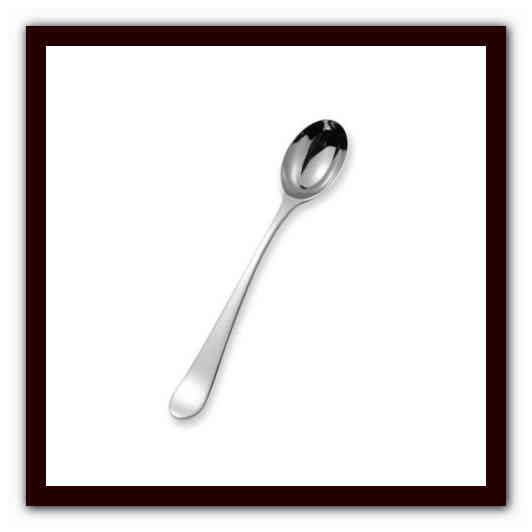
For many, the information that will tell you how many grams is in a coffee spoon may be of fundamental importance. So, again, everything is learned by comparison. Take the size of a teaspoon as the base and simply divide it in half. If we talk about water, then exactly half a teaspoon will fit in a coffee spoon - 2.5 g (ml). As for other products, let us remind you again that you need to take the size chart of a teaspoon as a base, and for coffee, divide the numerical characteristics in half.
General (auxiliary) spoons
Typically, these spoons are placed next to the dish for which they are intended.
A spoon for drinks and soups resembles a large spoon or a small ladle.
A serving spoon is necessary for main hot dishes. It can be recognized by its large size and the characteristic holder on top.
The sauce spoon is similar to the soup and drink spoon, but has a special spout.
A serving spoon is necessary for sour cream. It is similar to a soup and drink spoon, but has a more oval shape, making it very similar to traditional wooden spoons.
A salad spoon is larger in size compared to a tablespoon.
An egg spoon is the same size as a tablespoon, but has a distinctive scoop that widens towards the end and is elongated at the base.
The tea infuser is a wonderful tool for easily making tea, steeping herbs, etc.
The caviar spoon resembles a teaspoon, but has a less rounded shape. It looks more like a spatula.
Production material
What materials can a coffee spoon be made from? In most cases, these are stainless steel, precious metals (gold, silver, aluminum). As a gift option, coffee spoons are carved from wood. The walking standard is made of plastic. But manufacturers make cutlery from metal compositions: silver - gold, stainless steel - honey alloy. It is also worth mentioning that on sale you can see different gift options for coffee spoons: made of high-quality metal and in beautiful packaging. Another interesting fact is that it is customary for small children to be given tiny spoons for their first tooth or at birth. It’s great if it’s not a teaspoon, but still a coffee spoon. After all, it may turn out to be the baby’s first eating device at the time of introducing complementary foods, since it has a small, just suitable volume.
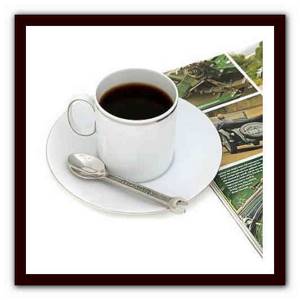
Material of manufacture
What materials can a coffee spoon be made from? Most often this is stainless steel, precious metals (gold, silver, aluminum). As a gift option, coffee spoons are carved from wood. The travel sample is made of plastic. However, manufacturers create cutlery from combinations of metals: silver - gold, stainless steel - medical alloy. It is also worth mentioning that you can see various gift options for coffee spoons on sale: made of high-quality metal and in beautiful packaging. Another interesting fact is that it is customary for small children to be given tiny spoons for their first tooth or for birth. It’s good if it’s not a teaspoon, but still a coffee spoon. After all, it can become the baby’s first cutlery at the time of introducing complementary foods, since it has a small, just suitable volume.

Purpose
It is very important to know how and when to serve a coffee spoon and when to serve a teaspoon. So, the names themselves already say a lot: when drinking tea, you need to put teaspoons on the table, but according to all the nuances of table etiquette, you need to serve coffee with small spoons.
It is important to remember that coffee spoons have different handle lengths. After all, for example, if a guest wants to drink iced coffee or Irish coffee, which is served in large glasses, then for this he needs to take a coffee spoon with a rather long handle. Otherwise, the unique table device will dive completely into the cup of drink.
Purpose
It is very important to know how and when to serve a coffee spoon and when to serve a teaspoon. So, the names themselves speak volumes: when drinking tea, you need to put teaspoons on the table, but according to all the rules of table etiquette, coffee should be served with small coffee spoons.
It is important to remember that coffee spoons have different handle lengths. After all, for example, if a guest wants to drink iced coffee or Irish coffee, which is served in tall glasses, then for this he needs to take a coffee spoon with a rather long handle. Otherwise, the original cutlery will dive completely into the cup of drink.
Table etiquette
A few words also need to be said about how correctly a coffee spoon should be served, in other words, how it should be positioned if you want to treat your loved one to coffee in all its nuances. It is important to remember that a cup of hot drink is almost always served on a saucer. The handle of the cup should look to the right and certainly be parallel to the table. A likely option is when dark coffee is served without grounds, in which case the handle of the cup may look to the left (certainly parallel to the table). But with all this, the coffee spoon always retains its standard position: it is placed behind the cup with the handle to the right of the person who will enjoy the fragrant drink.
Small conclusion
Now, if our readers have a teaspoon and a coffee spoon in front of them, no questions will arise. After all, it is now as clear as possible how these cutlery items differ: size and purpose. If, after everything you’ve read, it’s still unclear to you what a coffee spoon looks like, a photo is the first assistant in this matter. So, for convenience, it is better to look at our photos to see how a coffee spoon looks compared to a tea spoon, and draw certain conclusions for yourself. With all this, it is worth mentioning that for some people it is bad form when serving teaspoons with coffee. After reading our article, you can really avoid uncomfortable situations without any problems. After all, we informed you about everything.
Determine the weight of citric acid: how many grams are in a teaspoon?
Citric acid is one of the most common food additives used today. It is made from natural raw materials and is intensively used in cooking: it is added to drinks, mousses, sauces, soups, desserts and marinades for meat. This is a good preservative that allows you to increase the shelf life of fish, meat, vegetables, mushrooms, and fruits.
Citric acid is used in medicine, cosmetology, winemaking, and even for household purposes: it softens very hard water, cleans the surface of dishes and plumbing fixtures from dirt.
Small conclusion
Now, if our readers have a teaspoon and a coffee spoon in front of them, no questions will arise. Indeed, at the moment it is already extremely clear how these tableware items differ: size and purpose. If, after everything you’ve read, you still don’t understand what a coffee spoon looks like, a photo is your first assistant in this matter. So, for convenience, it is better to look at our photographs to see how a coffee spoon looks in comparison with a tea spoon, and draw certain conclusions for yourself. It is worth mentioning that for some people it is bad form when serving teaspoons with coffee. After reading our article, you can easily avoid awkward situations. After all, we informed you about everything.
How to find the weight of citric acid?
In some recipes the quantity is indicated in grams, so you need to find exactly how much product you need. Incorrectly taken proportions can spoil the taste of the finished dish or even harm beauty and health when it comes to the manufacture of cosmetics and pharmaceuticals. But from time to time there are no special scales at hand and you have to set the weight by eye using different table devices.
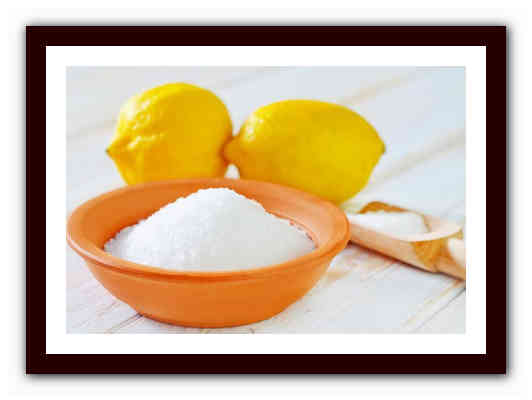
How many grams of citric acid are in 1 teaspoon is a very pressing question among housewives. The weight can be found quite accurately, but it is recommended to take into account that it will vary depending on whether the product was taken with a slide or without a slide.
Volume of substance in various eating devices
To find the exact amount of citric acid needed for a particular recipe, it is enough to use one of the cutlery devices that can be found in any kitchen. These are tablespoons, dessert and teaspoons.
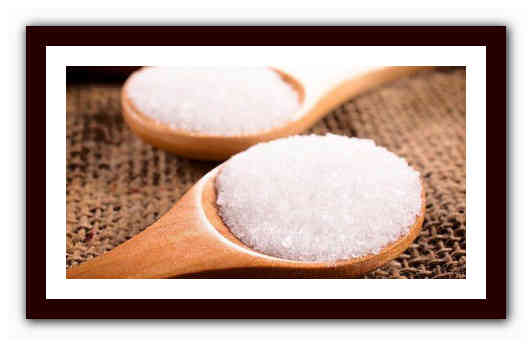
Determine the weight of citric acid:
- 20 grams in a heaped tablespoon - 15 without a heap;
- 13 grams in a dessert spoon with a slide - 10 without a slide;
- 7 in a heaped teaspoon - 5 g without a heap.
These are the simple standards for calculating citric acid. Nowadays, no matter what housewife knows how many grams are in a teaspoon, dessert or table spoon, she will be able to measure it exactly as needed according to the recipe. Without special scales, using ordinary kitchen utensils.
How many grams of citric acid are in a spoon (teaspoon, tablespoon).
For canning, making drinks and other culinary purposes, many people use citric acid, but what to do if there are no scales in the house and you need to measure out a certain amount of grams of lemon, in which case you can use ordinary spoons (table spoon, teaspoon). Let's try to find out in more detail how many grams of citric acid are in a teaspoon and a tablespoon, as well as how you can measure the required mass of citric acid according to a recipe using spoons.
Differences between a dessert spoon and a regular spoon
Dessert spoon – what kind of spoon is it? All types of spoons are united by their shape, which resembles a small spatula. A standard spoon consists of two parts: a scoop and an elongated handle connected to it. This device can be used not only for eating (as is commonly believed), but also for decoration and even during laboratory experiments.
The following types of spoons are used for table setting:
- dining room;
- dessert;
- tea room
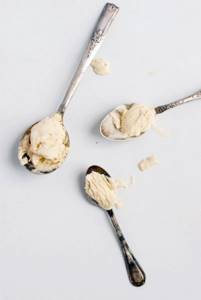
Some aesthetes also distinguish a special one. Moreover, if a tablespoon is a necessary utensil on every table, then the dessert spoon is very often forgotten, since dessert is not always present on the table. However, those with a sweet tooth will truly appreciate the dessert device.
A dessert spoon should be on the table if serving mousse, pudding, fruit in syrup, berries with cream, as well as other dishes that do not require cutting
Of course, no one will forbid you to eat desserts using an ordinary tablespoon, but using a device designed specifically for this is more aesthetically pleasing. Even the dish in this case will acquire a different taste.
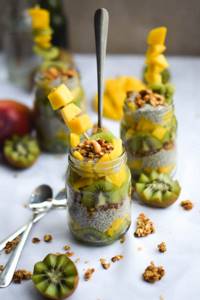
How many grams are in a teaspoon of citric acid?
One heaped teaspoon of citric acid contains 7 grams.
1 teaspoon contains 5 grams of citric acid without a slide.
Popular questions on the topic of how to measure citric acid without scales with a spoon (teaspoon, tablespoon)
Let us consider below the most necessary questions that may arise if you are not able to measure citric acid using a scale, but have a tablespoon or a teaspoon:
- How much is 2/3 heaping teaspoon of citric acid? 2/3 teaspoon of citric acid = approximately 2 grams of citric acid.
- 30 grams of citric acid is how many spoons? 30 g of citric acid = 2 level tablespoons of citric acid.
- 25 grams of citric acid - how many spoons? 25 g of citric acid = 1 heaped tablespoon of citric acid + 1 heaped teaspoon of citric acid.
- 20 grams of citric acid is how many teaspoons? 20 g of citric acid = 1 heaped tablespoon of citric acid.
- 15 grams of citric acid is how many teaspoons? 15 g of citric acid = 1 level tablespoon of citric acid = 3 level teaspoons of citric acid.
- 10 grams of citric acid is how many teaspoons? 10 g of citric acid = 2 level teaspoons of citric acid.
- 5 grams of citric acid is how many teaspoons? 5 g of citric acid = 1 level teaspoon of citric acid.
- 4 grams of citric acid is how many teaspoons? 4 g of citric acid = a little less than a level teaspoon of citric acid.
- 3 grams of citric acid is how many teaspoons? 3 g citric acid = just over half a teaspoon of citric acid.
- 2 grams of citric acid is how many teaspoons? 2 g citric acid = 1/3 (one third) teaspoon citric acid
- 1 gram of citric acid is how many teaspoons? 1 g citric acid = 1/5 teaspoon citric acid (at the tip of a spoon).
We also read articles on an identical topic:
In conclusion to the article, it can be noted that knowing how many grams of dried citric acid are in a tablespoon and a teaspoon, you can, without unnecessary hassle, measure in grams the required amount (mass) according to the recipe with the smallest errors. We leave our advice and feedback on the topic of how to measure citric acid without scales in the comments to the article and share it on social networks if it was useful to you.
How many grams of citric acid are in a spoon (teaspoon, tablespoon).

Very rarely you can meet a housewife who does not dream of pampering her family and friends with a delicious culinary masterpiece. But during the cooking process, you may encounter the fact that the recipe indicates a clear weight of the goods in grams.
Citric acid is included in many dishes - desserts, drinks, winter preparations. In order for the dish to be truly tasty, you should know how many grams of citric acid are in a spoon. This is very important, because if you exceed the recommended amount of citric acid a little, the taste of the prepared dish will be completely ruined.
Main types
Today, many types of spoons are produced, each type has its own function. However, there are varieties of this item, the use of which is undeniable.
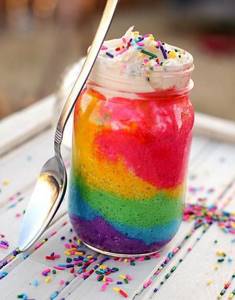
The main types are used:
1. A tablespoon used when serving the main meal.
2. A dessert spoon that is slightly smaller than the first. It is used when serving sweet dishes. It is also called a dessert tablespoon.
3. A teaspoon.
4. Coffee spoon.
How much citric acid is in a spoon?
In almost all culinary recipes, the weight of the product is indicated not in spoons, but in grams. Therefore, it is very important for every housewife to know how many grams of citric acid are in a tablespoon.
- Heaped tablespoon – 20 gr.
- Level tablespoon – 15 g.
- Heaped teaspoon – 8 g.
- Level teaspoon – 5 g.
In order to find out how many grams of citric acid are in a teaspoon, you must definitely take into account how the spoon is filled - with a slide or not. The correct proportions of goods will help turn each dish into a real culinary masterpiece.
Share “How many grams of citric acid are in a spoon (teaspoon, tablespoon)”
How many grams in a tablespoon: table.
Very often, almost all culinary recipes indicate a clear amount of the ingredient needed to prepare the dish. But not every housewife has special kitchen scales in her kitchen.
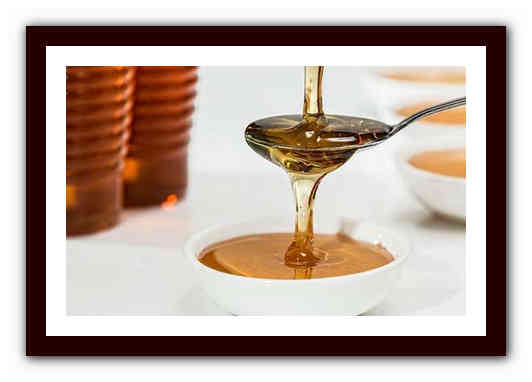
If you don’t have similar equipment at home, don’t despair. You can measure the required amount using a teaspoon, dessert or tablespoon.
A tablespoon is a table device. Its volume is 18 ml. This tableware is used for eating porridges, first courses or other watery culinary delights.
If you need to weigh a particular product, you should take into account the density of the ingredient and the “load” of the cutlery. Weight with and without a slide will vary from 4 to 6 grams.

The most common ingredients in the kitchen required to prepare a dish are sugar, flour and salt. Therefore, it is definitely worth knowing the measurements of these goods.
Table: measure of measurement.
How many grams of salt in a tablespoon:
• Table salt • Extra
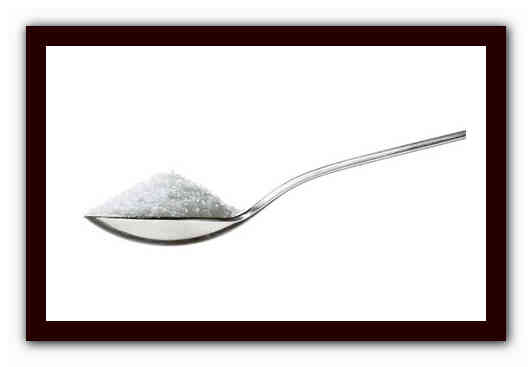
Table: measures of other ingredients needed for making dishes.
Honey is often used in almost all dishes. This is a very allergenic product, so it is worth knowing how many grams of honey are in a tablespoon, so as not to exceed its permitted dose. One spoon contains 30 g. honey, provided that it is a watery mixture.
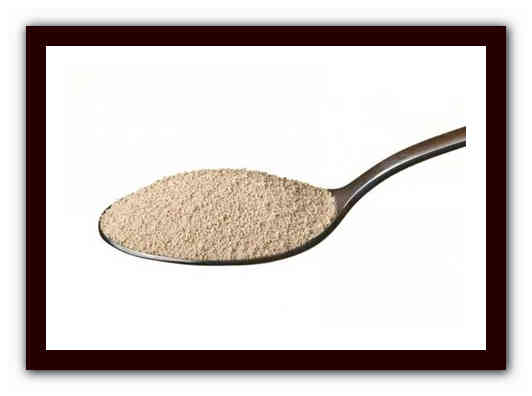
Tables like these help in the kitchen. They save ladies from the need to purchase unnecessary kitchen appliances and clutter up the kitchen space. This significantly saves the lady’s time, physical strength and money.
How many grams in a teaspoon: list
A teaspoon is a table device used for eating desserts, stirring tea, coffee or other hot drinks. The weight of the tableware with and without a slide varies from 3 to 6 grams. The volume of the tableware is 5 ml.
How many grams in a teaspoon of the most commonly used ingredients:
- Water – 5.
• Coarse grinding – 10. • Small grinding – eight.
- Sweet sand – eight.
- Wheat flour - eight.
Table: weight measures of different ingredients in tea cutlery.
